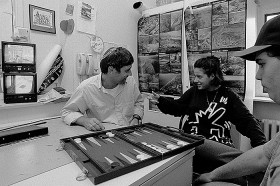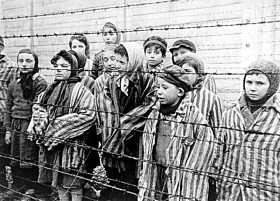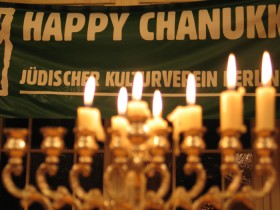Complementing our special exhibit, “Snip It! Stances on ritual circumcision”, our blogger team went looking for Jews and Muslims who could speak on the topic from a very personal perspective, whether for or against circumcising their sons. We called upon our networks of friends and acquaintances and received a range of responses in return. Some made us smile; others, like this one about David, gave us pause. It is retold to us by Shlomit Tulgan, our colleague in the education department who knows him from childhood:

Shlomit met David in the Jewish Culture Center in Berlin
On this photo you see a tutor of the Berlin Jewish Community’s youth center on Joachimstalerstr playing Backgammon with kids, Berlin 1992 © Photo: Michael Kerstgens, Jewish Museum Berlin
David was born to a secular Jewish mother and, at 22, chose to be circumcised in Berlin’s Jewish Hospital. His reason was to “get back to his roots and regain what his parents had denied him.” David was no “sad child,” remembers Shlomit, who met him most of all at the Berlin Jewish Community’s youth center on Joachimstalerstr. Seemingly every month he was in love with another Jewish girl, and he was popular among the opposite sex despite his nature to move swiftly from one to the next. The youth center was particularly supportive when the circumcision was performed. Recovering in a hospital bed, David’s Lebanese flatmate and friend → continue reading

Surviving children in the main concentration camp, Auschwitz. This still from documentary footage shot by Alexander Voronzow shows Tomasz Szwarz, Alicja Gruenbaum, Solomon Rozalin, Gita Sztrauss, Wiera Sadler, Marta Wiess, Boro Eksztein, Josef Rozenwaser, Rafael Szlezinger, Gabriel Nejman, Gugiel Appelbaum, Mark Berkowitz, Pesa Balter, Rut Muszkies, Miriam Friedman, and Miriam and Eva Mozes. Licensed for the public domain by the United States Holocaust Memorial Museum.
Seventy years ago to this day, the Soviet Army liberated the death camps Auschwitz I and II. Almost ten years ago, the anniversary was designated International Holocaust Remembrance Day. Although I’ve been reflecting on representations of the Holocaust in art, literature, and philosophy for many years, I remain irritatingly little affected by today’s date, January 27. In most European countries, official events will once again collectively recall that breach of civilization and commemorate those who were systematically murdered. So too will Germany. Here, the decision to officially commemorate the victims of the Holocaust on this day was reached in 1996—not least because → continue reading

Hanukkah Candleholder at the 15th Hanukkah Ball of the Jewish Cultural Center, Berlin 12.12.2004 © Photo: Igor Chalmiev, gift of the Jewish Cultural Center to the Jewish Museum Berlin
25 years ago today, on 22 January, 1990, the Jewish Cultural Center was founded. One month earlier, on 13 December, 1989, the press agency ADN published an appeal in numerous East German newspapers. It announced a new coalition of Jews living in East Germany who were committed to spreading the knowledge of Jewish culture and history. The appeal was not an accident:
As early as 1986, secular Jews had found themselves gathering, at the invitation of the Jewish Congregation of (East) Berlin, to explore their Jewish roots – a heritage that no longer played any role in their parents’ identities. A group called “We for us – Jews for Jews” formed out of this second generation of political emigrants who had returned to Germany and grown up in the East. During their regular meetings → continue reading


